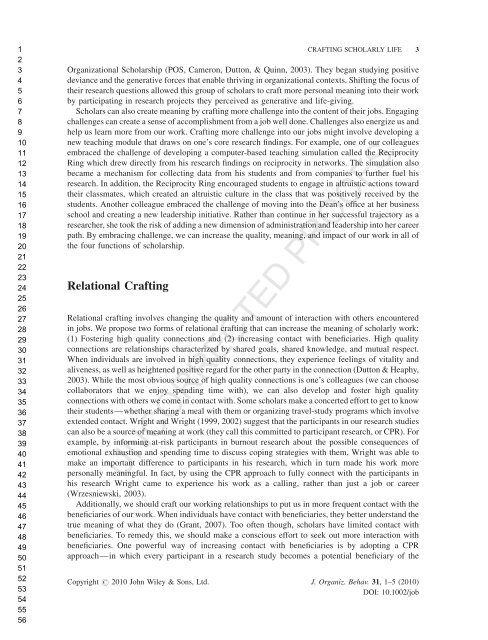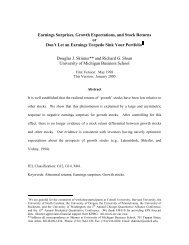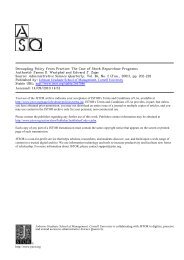proof of your article attached, please read carefully - Stephen M ...
proof of your article attached, please read carefully - Stephen M ...
proof of your article attached, please read carefully - Stephen M ...
Create successful ePaper yourself
Turn your PDF publications into a flip-book with our unique Google optimized e-Paper software.
1<br />
2<br />
3<br />
4<br />
5<br />
6<br />
7<br />
8<br />
9<br />
10<br />
11<br />
12<br />
13<br />
14<br />
15<br />
16<br />
17<br />
18<br />
19<br />
20<br />
21<br />
22<br />
23<br />
24<br />
25<br />
26<br />
27<br />
28<br />
29<br />
30<br />
31<br />
32<br />
33<br />
34<br />
35<br />
36<br />
37<br />
38<br />
39<br />
40<br />
41<br />
42<br />
43<br />
44<br />
45<br />
46<br />
47<br />
48<br />
49<br />
50<br />
51<br />
52<br />
53<br />
54<br />
55<br />
56<br />
Organizational Scholarship (POS, Cameron, Dutton, & Quinn, 2003). They began studying positive<br />
deviance and the generative forces that enable thriving in organizational contexts. Shifting the focus <strong>of</strong><br />
their research questions allowed this group <strong>of</strong> scholars to craft more personal meaning into their work<br />
by participating in research projects they perceived as generative and life-giving.<br />
Scholars can also create meaning by crafting more challenge into the content <strong>of</strong> their jobs. Engaging<br />
challenges can create a sense <strong>of</strong> accomplishment from a job well done. Challenges also energize us and<br />
help us learn more from our work. Crafting more challenge into our jobs might involve developing a<br />
new teaching module that draws on one’s core research findings. For example, one <strong>of</strong> our colleagues<br />
embraced the challenge <strong>of</strong> developing a computer-based teaching simulation called the Reciprocity<br />
Ring which drew directly from his research findings on reciprocity in networks. The simulation also<br />
became a mechanism for collecting data from his students and from companies to further fuel his<br />
research. In addition, the Reciprocity Ring encouraged students to engage in altruistic actions toward<br />
their classmates, which created an altruistic culture in the class that was positively received by the<br />
students. Another colleague embraced the challenge <strong>of</strong> moving into the Dean’s <strong>of</strong>fice at her business<br />
school and creating a new leadership initiative. Rather than continue in her successful trajectory as a<br />
researcher, she took the risk <strong>of</strong> adding a new dimension <strong>of</strong> administration and leadership into her career<br />
path. By embracing challenge, we can increase the quality, meaning, and impact <strong>of</strong> our work in all <strong>of</strong><br />
the four functions <strong>of</strong> scholarship.<br />
Relational Crafting<br />
CRAFTING SCHOLARLY LIFE 3<br />
Relational crafting involves changing the quality and amount <strong>of</strong> interaction with others encountered<br />
in jobs. We propose two forms <strong>of</strong> relational crafting that can increase the meaning <strong>of</strong> scholarly work:<br />
(1) Fostering high quality connections and (2) increasing contact with beneficiaries. High quality<br />
connections are relationships characterized by shared goals, shared knowledge, and mutual respect.<br />
When individuals are involved in high quality connections, they experience feelings <strong>of</strong> vitality and<br />
aliveness, as well as heightened positive regard for the other party in the connection (Dutton & Heaphy,<br />
2003). While the most obvious source <strong>of</strong> high quality connections is one’s colleagues (we can choose<br />
collaborators that we enjoy spending time with), we can also develop and foster high quality<br />
connections with others we come in contact with. Some scholars make a concerted effort to get to know<br />
their students—whether sharing a meal with them or organizing travel-study programs which involve<br />
extended contact. Wright and Wright (1999, 2002) suggest that the participants in our research studies<br />
can also be a source <strong>of</strong> meaning at work (they call this committed to participant research, or CPR). For<br />
example, by informing at-risk participants in burnout research about the possible consequences <strong>of</strong><br />
emotional exhaustion and spending time to discuss coping strategies with them, Wright was able to<br />
make an important difference to participants in his research, which in turn made his work more<br />
UNCORRECTED PROOFS<br />
personally meaningful. In fact, by using the CPR approach to fully connect with the participants in<br />
his research Wright came to experience his work as a calling, rather than just a job or career<br />
(Wrzesniewski, 2003).<br />
Additionally, we should craft our working relationships to put us in more frequent contact with the<br />
beneficiaries <strong>of</strong> our work. When individuals have contact with beneficiaries, they better understand the<br />
true meaning <strong>of</strong> what they do (Grant, 2007). Too <strong>of</strong>ten though, scholars have limited contact with<br />
beneficiaries. To remedy this, we should make a conscious effort to seek out more interaction with<br />
beneficiaries. One powerful way <strong>of</strong> increasing contact with beneficiaries is by adopting a CPR<br />
approach—in which every participant in a research study becomes a potential beneficiary <strong>of</strong> the<br />
Copyright # 2010 John Wiley & Sons, Ltd. J. Organiz. Behav. 31, 1–5 (2010)<br />
DOI: 10.1002/job







